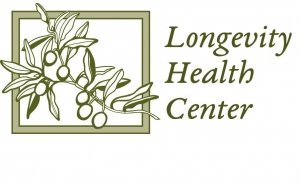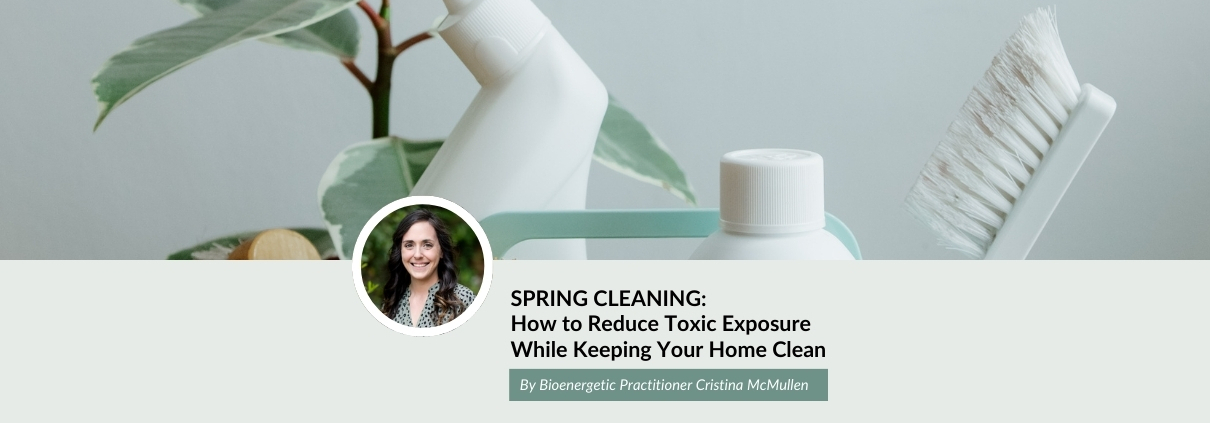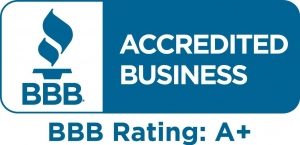Spring Cleaning: How to Reduce Toxic Exposure While Keeping Your Home Clean
By Cristina McMullen, ND, Certified Wellness Coach,
Bio-Energetic Practitioner
It’s hard to believe that spring is upon us. It’s that time of year when the days are becoming noticeably longer, the weather is getting warmer, and the sound of baby birds chirping reminds us of the new life all around us.
While a new year reminds us to set resolutions to eat better and exercise more, spring gives so many of us that “itch” to do a thorough, deep clean of our homes. There is just something about that clean house smell that correlates beautifully with the renewal of springtime.
One of the major downfalls to that deep clean of your house is the fact that so many cleaning supplies out there are full of chemicals that are toxic and very dangerous to our health. Anyone who has spent even 5 minutes in an enclosed space, say a shower, cleaning with a conventional bathroom cleaner will tell you that their skin, eyes, and sometimes even lungs burn while cleaning. What about noticing a headache after an afternoon of cleaning? These are signs that toxins are lurking in the products we are using. And just like we should try to eliminate our exposure to toxins in our food and personal body care products, we should do the same with our household cleaning products.
So what exactly is in those cleaning products that is so harmful to our health? Let’s identify some of these ingredients and find out why they are so bad for us.
Chlorine: Most of us are familiar with chlorine for its disinfecting and whitening properties. It is commonly found in scouring powders, laundry whiteners, toilet bowl cleaner, and mildew removers. We want to avoid chlorine because prolonged exposure can disrupt thyroid function, irritate the skin, and cause chronic skin dryness.
Ammonia: You can find ammonia in many polishing and glass cleaning products, especially those that promote that oh-so desired streak-free shine. Thankfully, you will see quite a few products promoting the fact that they are “ammonia free.” This is because we know it can produce highly irritating fumes that can be especially dangerous for those with asthma and other lung problems, as well as heart conditions.
* It is important to note here that you NEVER want to use chlorine and ammonia products together or at the same time. The combination of these two chemicals produces a dangerous gas that can cause major damage to the respiratory system.
Formaldehyde: This is another one most people have heard of before. As a cleaning agent, you will find it mostly in heavy duty cleaners. We most definitely want to avoid exposure to formaldehyde because it has been connected with the onset of amyotrophic lateral sclerosis, also known as ALS. Along with causing damage to the nervous system, formaldehyde can shift the balance of chemicals in the brain, which may lead to depression, mood swings, headaches, insomnia, irritability, and attention deficit disorders.
Perchloroethylene (PEC or PERC): This is a common chemical in fabric cleaners, such as upholstery cleaners, spot removers, and dry cleaning solutions. It is a known neurotoxin and carcinogen, so much so that the EPA has even banned PERC dry cleaning machines from being in residential buildings. The state of California has also demanded that all PERC machines be taken out of service by 2023.
2-Butoxyethanol: This chemical is very common in “multi-purpose” cleaners as well as window sprays and other kitchen cleaners. It is actually what gives certain cleaners their sweet smell. According to the EPA website, it is known to cause sore throats if inhaled directly. More seriously, when it is at a high level, it can cause pulmonary edema, narcosis, and severe kidney and liver damage. Even with all of these negative side effects, companies are not forced to list this as an ingredient in their products! This is so upsetting, especially when you find out that you can usually inhale more than is legally allowed in most workplaces!
Sodium Lauryl Sulfate (SLS): Found in soaps, shampoos, laundry detergent, and body washes, this is used as an emulsifier and foaming agent. Even though this is derived from coconuts, it becomes contaminated with a toxic byproduct in the process of making it. As a result, it becomes a carcinogenic endocrine disruptor and is toxic to our organs, neural tissues, and skin.
Phthalate: This chemical is usually used in air fresheners, soap labels, laundry detergents, and fabric softeners as a “fragrance.” Phthalates are known endocrine disruptors. Research from the Centers for Disease Control and Prevention as well as the Harvard School of Public Health have shown that men with higher phthalate compound in their blood have decreased sperm counts.
Paraben: Another synthetic chemical used as a “fragrance” even though it is a known endocrine disruptor. As a xenoestrogen, it mimics estrogen in our bodies and can interfere with the release of this hormone, leading to a multitude of reproductive issues in women.
Triclosan: Usually found in combination with triclocarban, this chemical is usually found in dishwashing detergents, hand soap, face wash, and toothpaste. It is used as an antimicrobial agent. Unfortunately, its use as an antimicrobial has helped to make certain bacteria resistant to antibiotics! It has also been linked to harmful effects on our liver, thyroid gland, and respiratory system.
Quaternary Ammonia Compounds (QAC): This is another antibacterial agent that is commonly used in our household cleaning products that aids in the production of antibiotic resistant microbes. It is also suspected to cause respiratory disorders like asthma and skin irritation.
Sadly, we could go on and on with even more chemicals currently allowed in our cleaning products that have harmful effects on our bodies. What then are we to do? How are we going to keep our homes free from dirt, dust, microbes, mold, and air pollutants?
Fortunately, there are a few things that we can all do to help keep our homes cleaner that don’t require the use of any cleaners whatsoever. By using door mats and taking our shoes off before entering into our homes, we can stop dirt and microbes from being tracked in to begin with. Vacuuming carpets and hardwoods along with damp dusting of furniture on a regular basis is an easy way to reduce the amount of not only dust, pet dander and airborne allergens, but can also lower our exposure to chemicals, heavy metals, and pesticides that are also lurking in those dust bunnies.
Running the exhaust fan in our bathrooms while showering is a great way to keep the moisture down and thus prevent the growth of mold. In the kitchen, we can have separate cutting boards for meat and vegetables to prevent cross-contamination. We can also replace kitchen sponges on a regular basis and make sure we wring them out thoroughly in order to keep them dry. If you want to disinfect these sponges, you can boil them in water for 3 minutes or microwave them for 1 minute (This is probably the only time I will recommend using a microwave!).
When it does come time to use cleaning solutions, we can choose to either find less toxic alternatives, or make our own. Fortunately, more and more people are becoming aware of the dangers of harmful chemicals in our environment, and manufacturers are starting to listen.
But how do you know which products are safe and which aren’t? This is where I LOVE to use the Environmental Working Group as a resource. Their website (www.ewg.org) has a Guide to Healthy Cleaning where you can either look up individual products to see how toxic they are or try to find the least toxic options on the market. Their list of “Top Green Cleaning Products” is an amazing resource for anyone looking to decrease the amount of toxins in their cleaning supplies.
Making your own cleaners will obviously be the least toxic option and really doesn’t have to be that intimidating. The internet is full of DIY recipes, but here are a few super simple ones that are made from things you most likely already have lying around in your home.
All Purpose Cleaner: Mix 1 cup of distilled white vinegar with 1 cup of water in a spray bottle. You can add a couple drops of your favorite essential oil (I prefer lemon of lavender) for a nice, natural fragrance.
Bathroom Cleaner: For surfaces that need a bit more scouring, rub baking soda into the desired surface with a wet sponge. You can add a few drops of liquid soap (Dr. Bronner’s will be the least toxic, but even Dawn dish soap will do) for a little more cleaning power.
Window Cleaner: Mix ½ cup of vinegar with 1 quart of warm water in a spray bottle. Again, you can add a couple drops of liquid soap for a bit more cleaning power.
Drain Cleaner: It is very easy to clear up minor clogs with just some baking soda, vinegar, and hot water. Start by pouring about ½ cup of baking soda down the drain, followed by about ½ cup of vinegar. After letting it bubble for a few minutes, you can pour boiling hot water down the drain. This may need to be repeated a few times for more stubborn clogs, or helped a bit with a mechanical snake.
Toilet Cleaner: Baking soda with some liquid soap and a scouring pad is usually all you need. Another option could be a non-chlorinated scouring powder from the store.
Oven: Even the tough, cooked on mess in the oven can be tackled with baking soda, a razor blade, and a copper scouring pad. Simply make a paste of baking soda with water and let it sit on the stuck on grime before using the razor and scouring pad to lift them up and remove them.
Garbage Disposal: Dumping just a bit of baking soda down the drain will do wonders for the garbage disposal. Since baking soda is a base, it will counteract the smelly acids from all the food we put down it.
Laundry Detergent: Probably one of my favorite homemade laundry detergents is made into a powder. Grate a 5oz bar of soap (I usually use Dr. Bronner’s) and mix it well with ½ cup of baking soda, 1 cup of super washing soda, ½ cup of citric acid, and ¼ cup of coarse sea salt. You can then store in an airtight container and add 1-2 Tbsp of detergent to each load. It’s fun to use a scented soap to add some natural fragrances to your detergent too.
Laundry Stain Remover: The honest truth is that there really is nothing better than a concentrated solution of dish soap as our first line of defense against stains from things like fatty foods and chocolate. Thankfully, dish washing liquids, even Dawn dish soap, are probably the least toxic of cleaning products out there, that is as long as they are not antimicrobial. Simply apply straight to the stain, rub in a but, and let it sit for a little while before washing it like you usually do.
Laundry Whitener: This is a bit of a tough one that does require some level of toxicity. However, using an oxygen bleach from the store or borax is going to be less toxic that chlorine.
Dryer Sheets: You can avoid the need for dryer sheets all together by getting some dryer balls. I personally love mine and add a few drops of essential oils (again, more lavender and citrus for me) to the balls before tossing them in the dryer.
But what about disinfecting?
This past year, we have all been told over and over again to disinfect surfaces in order to help prevent the spread of COVID-19. Soaps and cleaners like Lysol have been sold out of stores for months on end. But remember what I said about antimicrobial ingredients like triclosan and QAC? The use of these actually enables the production of antibacterial resistant superbugs! Another little fact that these products do not tell you is that they need to remain on surfaces for at least 10 minutes to truly kill bacteria anyways.
The real truth is, outside of healthcare settings, there really is no benefit to antimicrobial agents as opposed to plain ol’ soap and water. Germs don’t necessarily need to be killed, but rather just need to be washed away. So, regular cleaning of countertops and surfaces with soap and water along with good rinsing afterwards is enough to lift dirt and microbes away. And, if the need for disinfecting occurs, using a little bit of bleach with a face covering will go a long way.
Feel free to ask me or another Longevity team member about our favorite cleaning products or DIY recipes. And, in the meantime, Happy Spring Cleaning!


